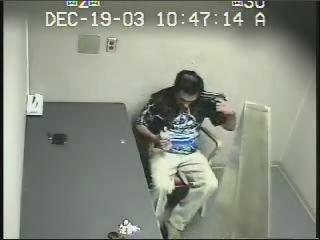Claim: Video shows a suspect in a police shooting committing suicide in an interview room.
Example: [Collected via e-mail, 2004]
Is this video real?
GRAPHIC IMAGE WARNING: Video shows a suicide by gunshot.
Origins: Movies and television have planted sensationalized images of certain phenomena into the public consciousness, to the extent that when most of us see the real thing, we're disappointed that it seems so mundane. In films and television programs, automobile crashes are always slam-bang affairs that inevitably end with one or more cars bursting into flame and exploding; thunder is always a very loud, sharp, and short report which occurs simultaneously with a bolt of lightning (rather
than a slow, distant, gradually increasing rumbling which arrives well after the lightning flash); and gunshots are usually depicted as producing ear-splitting volumes of sound and, when aimed at another human being, resulting in plenty of gore and splatter.
It's no wonder, then, that when the above-displayed video of a detainee shooting himself while in police custody began to circulate, many viewers were skeptical of its
But what we see in the video is nothing like what most of us might expect. The soon-to-be suicide victim is neither visibly nervous nor distraught as he freely pulls out a gun and places it against his head. (He even replaces the cap on the water bottle before pulling the trigger.) The weapon does not produce an ear-shattering concussive

sound in the small room, blood and brain matter don't splatter all over the walls, and the victim's body isn't hurtled out of the chair and onto the floor. The gun makes a sharp popping sound as the suspect shoots himself, blood streams from the victim's head and mouth, his hands drop the gun and water bottle to the floor, and his body slumps but slightly in the chair.
Even more unusual to many viewers is the officer's reaction to this event. He doesn't respond with any of the emotions most of us might feel, such as fear, panic, terror, or disgust. Nor does he rush to the victim's aid, check him for signs of life, summon help, or otherwise raise an alarm. "Oh, fuck," he exclaims as he
(We realize, of course, that all of this would be viewed quite differently from a police perspective. Officers undergo thorough instruction in the handling and use of firearms, they generally see far more blood and violence on the job than most of us will experience in our lifetimes, and they're trained to respond to emergency situations by following proper procedure rather than reacting with fear or panic. We're simply presenting the average person's reaction to this video, as reflected in the
The circumstances behind this video took place on 19 December 2003, when 47-year-old Ricardo Alfonso Cerna was stopped for a traffic violation at about
When Dean stepped out of the room briefly to speak with a detective in the hallway, Cerna pulled the
Penrod said confusion among the three agencies "Obviously there was a mistake made," Penrod said by phone. "It was hectic and it was a guy who was cuffed by somebody other than the transporting officer.
[Sheriff Gary] Penrod said deputies failed to adequately search Cerna before he was put in a car, and again when he was transferred to the homicide division office. Each receiving deputy may have wrongly assumed the previous officer adequately searched the man, he said.
(This apparently egregious oversight led to conspiracy-theory speculation in some quarters that Cerna had been "executed" by the
As to how the video of Cerna's suicide made it onto the Internet, sheriff's spokesman Chip Patterson said:
Following the presentation, dozens of copies of the video were made at the request of law-enforcement agencies across the country. Officials of those agencies wanted the copies for training purposes.
[A] ranking official at the department was authorized to show the video during a presentation on officer safety at the FBI's training academy in Quantico, Va., several months ago.
Sheriff's officials do not know who might have leaked the video to the public. Some of the officers involved in Cerna's arrest and handling were subjected to disciplinary action, but sheriff's officials wouldn't comment on the specifics of that action or identify the officers involved.
Last updated: 19 January 2014
Sources: |
Grenda, Tim and Imran Ghori. "Man in Custody Had Hidden Gun." The [Riverside] Press-Enterprise 20 December 2003. Nelson, Joe. "Sheriff's Detainee's Suicide Put on Web." San Bernardino County Sun. 21 December 2004. Associated Press. "Arrestee Pulls Hidden Gun, Kills Self." CNN.com. 20 December 2003.
